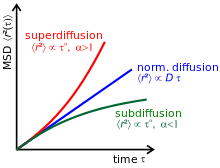Anomalous diffusion

 for different types of anomalous diffusion
for different types of anomalous diffusionAnomalous diffusion is a diffusion process with a non-linear relationship to time, in contrast to a typical diffusion process, in which the mean squared displacement (MSD), σr2, of a particle is a linear function of time. Physically, the MSD can be considered the amount of space the particle has "explored" in the system.
Unlike typical diffusion, anomalous diffusion is described by a power law,[1][2] σr2 ~ Dtα, where D is the diffusion coefficient and t is the elapsed time. In a typical diffusion process, α = 1. If α > 1, the phenomenon is called super-diffusion. Super-diffusion can be the result of active cellular transport processes. If α < 1, the particle undergoes sub-diffusion.[3]
The role of anomalous diffusion has received attention within the literature to describe many physical scenarios, most prominently within crowded systems, for example protein diffusion within cells, or diffusion through porous media. Sub-diffusion has been proposed as a measure of macromolecular crowding in the cytoplasm.
Recently, anomalous diffusion was found in several systems including ultra-cold atoms,[4] Telomeres in the nucleus of cells,[5] in single particle movements in cytoplasm,[6] and in worm-like micellar solutions.[7] Anomalous diffusion was also found in other biological systems, including heartbeat intervals and in DNA sequences.[8]
Types of Anomalous diffusion
Of interest within the scientific community, when one an anomalous-type diffusion process, is to then understand the underlying mechanism which has caused it. There are a number of frameworks which give rise to anomalous diffusion that are currently in vogue within the statistical physics community. These are continuous-time random walks (CTRW) and fractional Brownian motion (fBm), and diffusion on fractal topology.
See also
- Lévy flight
- Random walks
- Percolation
- Long term correlations
- long range dependencies
- Hurst exponent
- Detrended fluctuation analysis [DFA]
- Fractals
References
- ↑ Ben-Avraham, Havlin (2000). Diffusion and Reactions in Fractals and Disordered Systems. Cambridge University Press.
- ↑ S. Havlin, D. ben-Avraham (2002). "Diffusion in disordered media". Adv. Phys. 51: 187. Bibcode:2002AdPhy..51..187H. doi:10.1080/00018730110116353.
- ↑ Ahmad Sharifi-Viand, Investigation of anomalous diffusion and multifractal dimensions in polypyrrole film, Journal of Electroanalytical Chemistry(Elsevier), 671: 51–57 (2012).
- ↑ Sagi, Yoav; Brook, Miri; Almog, Ido; Davidson, Nir (2012). "Observation of Anomalous Diffusion and Fractional Self-Similarity in One Dimension". Physical Review Letters 108 (9). arXiv:1109.1503. Bibcode:2012PhRvL.108i3002S. doi:10.1103/PhysRevLett.108.093002. ISSN 0031-9007.
- ↑ Bronshtein, Irena; Israel, Yonatan; Kepten, Eldad; Mai, Sabina; Shav-Tal, Yaron; Barkai, Eli; Garini, Yuval (2009). "Transient anomalous diffusion of telomeres in the nucleus of mammalian cells". Physical Review Letters 103 (1). Bibcode:2009PhRvL.103a8102B. doi:10.1103/PhysRevLett.103.018102.
- ↑ Regner, Benjamin M.; Vučinić, Dejan; Domnisoru, Cristina; Bartol, Thomas M.; Hetzer, Martin W.; Tartakovsky, Daniel M.; Sejnowski, Terrence J. (2013). "Anomalous Diffusion of Single Particles in Cytoplasm". Biophysical Journal 104 (8): 1652–1660. Bibcode:2013BpJ...104.1652R. doi:10.1016/j.bpj.2013.01.049. ISSN 0006-3495.
- ↑ Jeon, Jae-Hyung; Leijnse, Natascha; Oddershede, Lene B; Metzler, Ralf (2013). "Anomalous diffusion and power-law relaxation of the time averaged mean squared displacement in worm-like micellar solutions". New Journal of Physics 15 (4): 045011. Bibcode:2013NJPh...15d5011J. doi:10.1088/1367-2630/15/4/045011. ISSN 1367-2630.
- ↑ Buldyrev, S.V.; Goldberger, A.L.; Havlin, S.; Peng, C.K.; Stanley, H.E. (1994). "Fractals in Biology and Medicine: From DNA to the Heartbeat". In Bunde, Armin; Havlin, Shlomo. Fractals in Science. Springer. pp. 49–89. ISBN 3-540-56220-6.
- Matthias Weiss, Markus Elsner, Fredrik Kartberg, and Tommy Nilsson. "Anomalous Subdiffusion Is a Measure for Cytoplasmic Crowding in Living Cells." Biophysical Journal 87 : 3518-3524 (2004)
- Jean-Philippe Bouchaud, Antoine Georges, "Anomalous diffusion in disordered media." Physics Reports 195 (4-5) : 127-293 (1990).
- A. von Kameke et al., "Propagation of a chemical wave front in a quasi-two-dimensional superdiffusive flow", Phys. Rev. E 81 6 (2010).
- Wen Chen, HongGuang Sun, Xiaodi Zhang, Dean Korosak "Anomalous diffusion modeling by fractal and fractional derivatives". Computers and Mathematics with Applications, 59 (5): 1754-1758 (2010).
- HongGuang Sun, Mark M. Meerschaert, Yong Zhang, Jianting Zhu, Wen Chen. "A fractal Richards' equation to capture the non-Boltzmann scaling of water transport in unsaturated media". Advances in Water Resources, 52: 292-295 (2013).